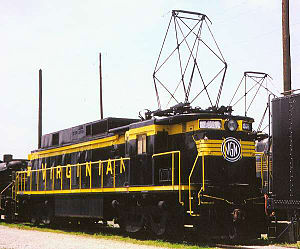VGN class EL-C
| VGN EL-C | |
|---|---|
|
Locomotive 135 preserved in the Virginia Museum of Transportation
|
|
| Numbering: |
VGN EL-C 130-141 N&W EL-C 230-241 NH EF-4 300-310 PC E33 4601-4610 CR E33 4601-4610 |
| Number: | 12 |
| Manufacturer: | General Electric |
| Year of construction (s): | 1955-1957 |
| Retirement: | 1981 |
| Axis formula : | Co'Co ' |
| Gauge : | 1435 mm ( standard gauge ) |
| Length over buffers: | 21,180 mm |
| Height: | 4,825 mm |
| Service mass: | 158 t |
| Top speed: | 105 km / h |
| Hourly output : | 2390 kW (3250 hp) |
| Starting tractive effort: | 440 kN |
| Continuous tensile force: | 350 kN at 25.2 km / h |
| Power system : | 11 kV 25 Hz ~ |
| Power transmission: | Catenary |
| Number of traction motors: | 6th |
| Drive: | Pawbearing drive |
The EL-C of the Virginian Railway (VGN) were electric locomotives for 11 kV 25 Hz alternating current supplied by General Electric (GE) . They were used to transport coal trains on the electrified Elmore - Roanoke section of the main line of the railway. After the cessation of electrical operations at the Virginian Railway, the locomotives came to New Heaven and were also taken over by the successor railways until they were scrapped in the early 1980s.
history
The Virginian Railway put 12 locomotives with mercury vapor rectifiers into operation in the 1950s . They replaced the first locomotives of the EL-3A series , which were delivered from 1925 for the electrical operation of the railway , which had reached the end of their service life. The first EL-C was delivered in August 1955, the remaining 11 locomotives followed between October 1956 and January 1957.
In 1959 the Virginian Railway was taken over by the Norfolk and Western Railway (N&W), which no longer had any interest in electrical operation and ceased it on June 30, 1962. The locomotives with the number 230 were converted into a road slug - a unit that receives the power for the traction motors from a neighboring diesel locomotive and thus only serves to increase the number of driven axles, but not the power for the train movement. It was given the new number 180.
All EL-C locomotives came to the New York, New Haven and Hartford Railroad (NH), better known as New Haven , in 1963 . This railway was almost insolvent, which is why the locomotives were sold by N&W at a very affordable price. All locomotives, spare parts included, changed for just 300,000 US dollars to the owner, which was about the original price of a single locomotive. At New Haven, the locomotives were referred to as EF-4 for " E lectric F reight Class 4" and were nicknamed Virginians by the railroad workers for their origin and Bricks "bricks" for their appearance. After the locomotives had been cleaned of the coal dust from the previous owner, the eleven locomotives with the new numbers 300 to 310 were used in freight train service, the N&W 180, which had been converted into a road slug, was given the number NH 311, but only served as a spare parts dispenser. The 301 was scrapped after an accident.
Ten locomotives came to Penn Central , which were designated as the E33 series, with the 33 standing for 3,300 hp. The new numbers were 4601 to 4610. The locomotives initially stayed in their traditional area of operation. Simultaneously with the formation of Conrail , Amtrak was also created, which took over the Northeast Corridor north of New York City and no longer allowed goods traffic there. The E33 came south of New York City on the former route network of the Pennsylvania Railroad , where they remained in use until the cessation of electrical operation in March 1981.
Two locomotives have been preserved: the former VGN 135 is in the Virginia Transportation Museum in Roanoke, the former VGN 132 first came to the Railroad Museum of New England and was given to the Illinois Railway Museum in August 2015 .
technology
The current taken from the contact line was reduced by a transformer to a voltage suitable for the traction motors , which could be regulated with a step switch . The current was of Einanoden rectifiers in DC converted and supplied to the traction motors. Because of the rectifier, the VGN's locomotives were nicknamed AC Rectifiers by the railway staff. The rectifier consisted of 12 Ignitron tubes measuring 30 cm in diameter , which worked with mercury vapor . A weak point in terms of reliability was the control of the ignition electrode and the cooling of the system.
The electrical equipment was housed in a structure with a short and long narrow front end, as is common for North American diesel locomotives and is known as a road switcher arrangement . The only pantograph was located above the driver's cab. It was driven by six drive motors in the cradle bearing , which were housed in two 3-axle bogies .
Individual evidence
- ↑ a b Virginian Railway GE EL-C electric Ignitron rectifier locomotive is seen at the railroad museum in Roanoke, Virginia, August 1985. In: Flickr - Photo Sharing! Retrieved June 26, 2016 .
- ^ The New Haven RR in 1959: Gone But Not Forgotten. In: newhavenrailroad1959.webs.com. Retrieved June 25, 2016 .
- ^ Illinois museum acquires well-traveled electric locomotive from New England. Trains Magazine, accessed June 26, 2016 .
